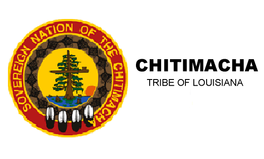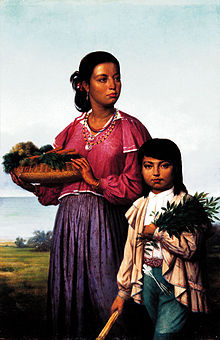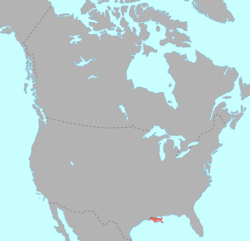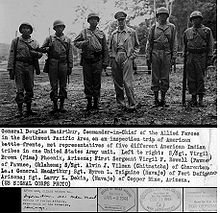- Chitimacha
-
Chitimacha Total population 720 Regions with significant populations United States (Louisiana) Languages English, Chitimacha language (historical), Cajun French
Religion Catholicism, other
The Chitimacha (also Chitimachan, Chetimacha) are a Native American federally recognized tribe that lives in the U.S. state of Louisiana, mainly in St. Mary Parish. They currently number about 720 people. The Chitimacha language is a language isolate.
History
The Chitimacha's historic home was the southern Louisiana coast. They and their ancestors lived there for about 2,500 years and perhaps as long as 6,000. They had migrated from the area surrounding modern Natchez, Mississippi, and before that, from eastern Texas.
In the early 18th century, the Chitimacha encountered French colonists, who raided their territory in search of slaves. By the time peace was reached in 1718, the population had declined drastically, through exposure to new infectious diseases to which they had no immunity and warfare. Survivors were forced to move north.
One hundred years later, the arrival of Acadian refugees in their area brought a further decline in the Chitimacha population.
General Douglas MacArthur meeting with Native American troops in 1943, including one of only 70 then-living Chitimacha: S/Sgt. Alvin J. Vilcan of Charenton, La.
Some members married Acadians and became acculturated to their community, including converting to Catholicism. New settlers grabbed land. In 1917, the tribal leadership sold what was left of the Chitimacha land to the United States government. By 1930, the Chitimacha population had dropped to just 51 people.
Since that low, the population has climbed as the people have recovered. There are 720 registered Chitimacha. The 2000 census reported a resident population of 409 persons living on the Chitimacha Indian Reservation. Of these, 285 were of solely Native American ancestry. The reservation is located at 29°53′02″N 91°31′52″W / 29.88389°N 91.53111°W in the northern part of the community of Charenton, in St. Mary Parish. It has the Chitimacha Tribal School, sponsored by the Bureau of Indian Affairs. The governing Council is involved in ongoing negotiations with the United States to obtain compensation for the land expropriations of the past. The reservation is quite small, with a land area of only 1.059568 square kilometres (261.825 acres).
The Chitimacha Indians inhabited the Mississippi Delta area of South Central Louisiana before the arrival of Europeans. Tradition asserts that the boundary of the territory of the Chitmacha was marked by four prominent trees. The Chitimacha were divided into four sub tribes: the Chawasha, Chitimacha, Washa and Yagenachito. This confederation occupied about fifteen villages.
At the time of Columbus’ discovery of America, the combined strength of the four groups was about 20,000. Although the Chitimacha were to have virtually no contact with Europeans for two more centuries, they suffered Eurasian infectious diseases contracted from other natives, to which they lacked immunity. Epidemics had reduced their number by half by 1700, when the French began to enter the Mississippi Valley. At that time, the Chawasha had about 700 people, the Washa about 1400, the Chitimacha some 4,000; and about 3,000 for the Yagenichito.
According to the Chitimacha, their name comes from the term Pantch Pinankanc, meaning ‘men altogether red.’ The name Chawasha is a Choctaw term for ‘Raccoon Place.’ Washa is also Choctaw and means ‘Hunting Pace.’ Yaganechito means ‘Big country.’ The Chitimacha spoke a dialect of the Tunica language, an isolate. The Chitimacha language has become extinct. Contemporary Chitimacha speak Cajun French and English.
Archaeological finds suggest that the Chitimacha and their ancestors have been living in Louisiana for perhaps 6,000 years. Prior to that they came from somewhere west of the Mississippi. The fifteen or so villages which the French came across at the beginning of the 18th century were self-governing groups. A central governing authority was vested in the person of the Grand Chief.
The villages of the Chitimacha were situated in the midst of swamps and rivers. Such locations provided a natural defence to enemy attack and made these villages almost impregnable. Extra fortification was deemed unnecessary. The villages were rather large, with an average of about 500 inhabitants. Dwellings were constructed from whatever resources were available. Typically the people built walls from a framework of poles and plastered them with mud or palmetto leaves. The roofs were thatched.
The Chitimacha raised a variety of crops, and agricultural produce provided the mainstay of their diet. The women tended cultivation and the crops and, as in other tribes, they were skilled horticulturalists, raising numerous, distinct varieties of corn, beans and squash. Corn was the main crop, supplemented by beans, squash and melons. The women also gathered wild foods and nuts. The men hunted for such game as deer, buffalo, turkey and alligator. They also caught fish. The people stored grain crops in an elevated winter granary to supplement hunting and fishing.
The main mode of transport for the Chitimacha was by dugout canoe. These vessels were constructed from cypress logs. The largest could hold as many as forty people. The one essential the homeland of the Chitimacha did not provide was stone, needed to fashion arrowheads and tools. To obtain these, the people traded crops for stone with tribes to the north. To compensate for the lack of stone, the Chitimacha developed such weapons as the blow gun and cane dart. They adapted fish bones to use as arrowheads.
The Chitimacha were distinctive in their custom of flattening the foreheads of their male babies. Adult men would typically wear their hair long and loose. They were skilled practitioners of the art of tattooing, often covering their face, body, arms and legs with tattooed images. Because of the hot and humid climate, the men would normally only wear a breechcloth, and the women a short skirt.
The Chitimacha were divided into a class system, with nobles and commoners. So large was the distinction between the two that they spoke different dialects. Intermarriage between the classes was forbidden.
Between the years 1706–18, the Chitimacha engaged in a long, bitter war with the French. The result was that the eastern Chitmacha were nearly wiped out. Those who survived were resettled by the French along the Mississippi River. Infectious disease and alcohol took a toll on the tribes. By 1784 the combined numbers of the tribes had fallen to just 180. In the early part of the 19th century, they were absorbed by the Houma.
In the early 20th century, however, the Chitimacha began to re-establish their tribal identity. From just six families in 1880, the numbers have grown to reach a present figure of about 900. In 1917, the Chitimacha were officially recognised as a tribe by the United States government.
References
- Chitimacha Reservation, Louisiana United States Census Bureau
Links
Categories:- Native American tribes in Louisiana
- Indigenous peoples of the Southeastern Woodlands
- Federally recognized tribes in the United States
Wikimedia Foundation. 2010.




